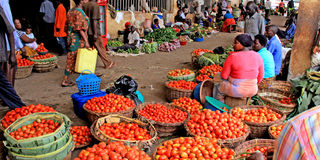Prime
Economy facing upside inflationary risks, say BoU

Food vendors at Mbale Main Market in December 2020. Prices of major food items across the country have gone high. PHOTO/Rachel Mabala
What you need to know:
- The increase in EFU inflation was largely attributed to a rise in domestic fuel prices.
Uganda’s central bank has warned that inflation could accelerate in months ahead owing to the rises in energy and food prices.
Household spending—particularly on services—is forecast to be higher due to the full opening of the economy.
In his monetary policy statement of February, Mr Michael Atingi-Ego, the Bank of Uganda deputy governor, revealed that “inflation is forecast to rise but stabilise at around the five percent target contingent on the evolution of the pandemic.”
ALSO READ: Don’t take Ugandans’ resilience for granted
He hastened to add: “There could be inflation surprises, however, because of a strong rise in food crop, commodity and import prices, and the exchange rate depreciation.”
The central bank is concerned that if the upswing in global cost-push inflation pressures turns out to be larger or more persistent than currently expected, the domestic economy could be negatively impacted.
“If the exchange rate were to depreciate significantly, partly on account of higher demand for foreign currency and monetary policy tightening in advanced countries, this would increase the overall inflation pressures and foster a need for tightening monetary policy going forward,” Mr Atingi-Ego cautioned.
Uganda’s annual headline inflation recorded a six-month average of 2.3 percent in the first half of Financial Year 2021/2022, up from a 2.2 percent average in the previous half.
The increase in annual headline inflation was attributed to a rise in both food crops and energy fuel and utilities (EFU) inflation rates. Food crop prices increased due to a rise in demand alongside reduced supply, following less than average rainfall that translated into lower crop harvests.
The EFU inflation rose as domestic fuel prices increased in tandem with the rise in international oil prices.
In its half year macroeconomic and fiscal performance report for Financial Year 2021/2022, the Ministry of Finance, Planning and Economic Development revealed that the core inflation declined to a six-month average of 2.4 percent in the first half of the financial year from 3.1 percent in the previous half.
The decline in core inflation was down to the slower pace at which costs of transportation services increased. Transport costs have been high since 2020 when transport operators hiked transport charges following pandemic-triggered restrictions in vehicle capacity.
Food crop inflation
Annual Food crop inflation increased to a 2.1 percent average during the first half of the Financial Year from a -3.7 percent average in the previous half. Throughout the previous half, food crop prices were on a downward trend.
The first half of Financial Year 2021/22 however saw a reversal in this trend with food crop inflation turning positive and increasing, reflecting a gradual increase in prices of food crops.
The rise in food crop prices was largely attributed to a pickup in demand amidst reduced supply following less than average rainfall that translated into lower crop harvests. Some of the food crops whose prices increased significantly include pawpaw, passion fruits, cabbage, tomatoes, green pepper, onions, garlic, yams, matooke and sweet potatoes.
ALSO READ: War, inflation threaten world economy
EFU inflation also increased to a six month’s average of 0.6 percent during the first half of the Financial Year 2021/2022 from a -2 percent average during the previous half.
The increase in EFU inflation was largely attributed to a rise in domestic fuel prices particularly petrol, diesel, paraffin and liquefied gas prices, whose increase was a feed through effect of the soaring international oil prices witnessed in the same period.




